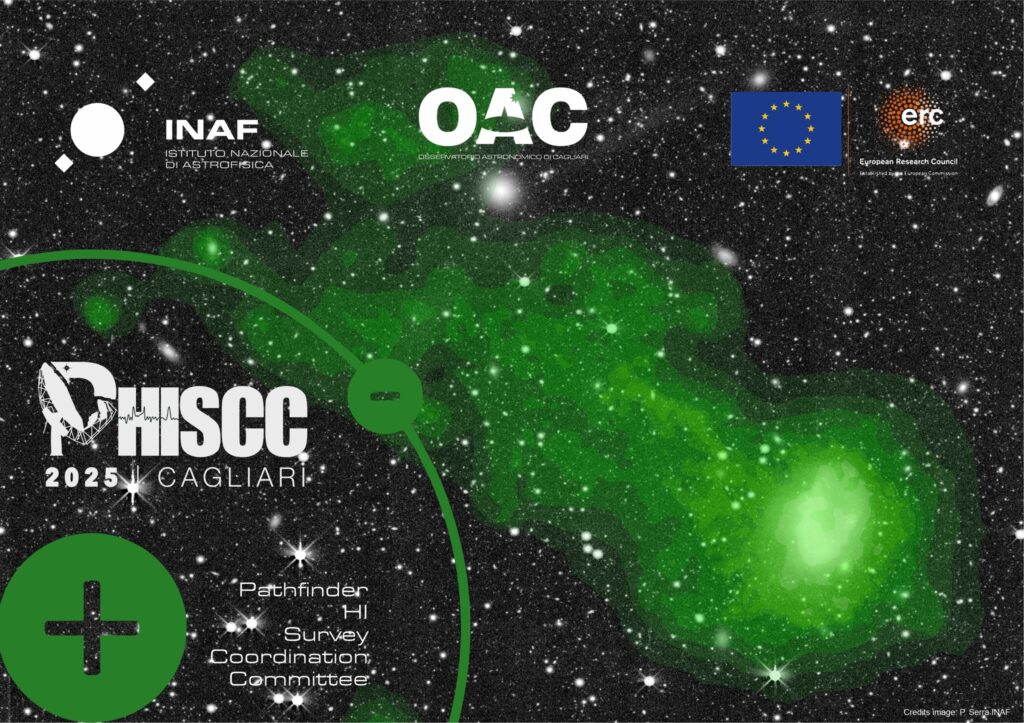
Here is the second, very important September meeting of our observatory: PHISCC, which will take place from 22 to 26 September 2025 in the Sardinian capital, coordinated by astrophysicist Paolo Serra of the INAF in Cagliari.
PHISCC stands for Pathfinder HI Survey Coordination Committee, a group of astronomers formed in 2009 to coordinate activities in preparation for observations of neutral atomic hydrogen (HI) with radio telescopes that are precursors to the large SKA (Square Kilometre Array) project.
The objective of PHISCC has since evolved to bring together astronomers specialising in HI globally, not only to facilitate the planning of observations but above all to discuss results and observational techniques and to strengthen scientific value, with particular regard to the involvement of young researchers in order to grow the community. This objective is achieved mainly through the organisation of annual PHISCC workshops.
In the electromagnetic spectrum – that is, the vast container in which we can identify all possible electromagnetic waves and divide them by type, length and frequency – there is a specific frequency that is crucially important for the study of the universe. It is so important that it is protected from civil and military interference and dedicated solely to radio astronomy, i.e. to telescopes with receivers capable of receiving it from distant objects such as galaxies, galaxy clusters, star-forming regions, etc.
This frequency is 1.42 GHz and detects only one element: neutral atomic hydrogen, HI. The wave emitted by HI therefore oscillates 1 billion 420 million times per second. Since electromagnetic waves travel, at least in a vacuum and in theory, at the speed of light, and light travels approximately 300,000 km in one second, if we divide this distance by the number of oscillations, we obtain electromagnetic waves 21.1 cm long.
Technically, we are in a borderline area between radio waves and microwaves, which are shorter and more energetic. In particular, 21 cm waves fall into the UHF (Ultra High Frequency) category, which is the range following the much better known VHF (Very High Frequency) used by radio amateurs.
But what does neutral atomic hydrogen mean? It is a special case of the three possible states of hydrogen in which a single atom has an electron that revolves peacefully around its proton without being disturbed, thus remaining unionised and, therefore, neutral.
In order to enjoy this neutrality and perfect solitude, the HI atom must remain at a safe distance from its counterparts, floating in areas where, precisely because of the rarity of atoms in circulation, temperatures do not reach levels that cause them to aggregate, except sporadically.
Although distributed over enormous spaces and therefore very diluted, HI atoms are extremely numerous and can therefore be observed by radio telescopes. However, their radiation is not continuous at all; in fact, a single emission per atom has been calculated every 11 million years! But there are so many of them that the emission can be observed constantly.
Most of the cold interstellar medium in galaxies, from which stars are formed, is made up of HI. Understanding the processes of HI accretion and loss is therefore essential to understanding why some galaxies (such as the Milky Way) continuously form new stars while others are no longer capable of doing so. The processes of HI accretion and loss are linked both to what happens inside galaxies – where, for example, HI can flow towards the black hole at the centre of the galaxy or be ejected by highly energetic phenomena such as supernova explosions — but also to how they interact with their surroundings, as we observe HI flows between neighbouring galaxies and between them and the intergalactic medium.
Thanks to the Doppler effect, observing HI also allows us to study the motion of the interstellar medium in galaxies. Just as the mass of the Sun can be deduced from the motion of the planets around it, the motion of the interstellar medium allows us to deduce the total distribution of matter in galaxies. For this reason, HI observations played a key role in the discovery of dark matter and still play a primary role in the study of its properties.
HI is a tracer, meaning that by observing its presence, we can trace the structure of entire galaxies or parts of them, such as individual arms, as well as the distribution of mass within them. On an even larger scale, it is possible to identify gas flows between galaxies in the intergalactic medium, demonstrating how everything in the universe is intimately connected, even enormous structures millions of light years apart.